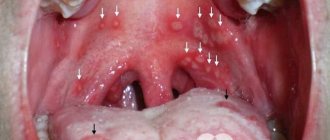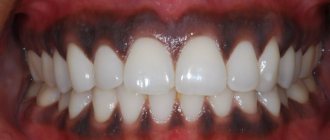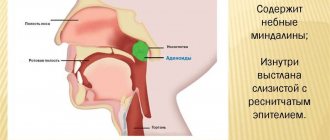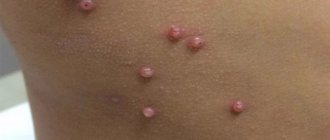White coating on the tongue can be localized in any area of the tongue and be grayish-white in color. The plaque may cover the entire tongue, or appear in the form of spots. There are several different causes of white plaque, and each of them is treated differently. White plaque is usually a harmless symptom, but in rare cases it can cause serious illness.
In this article, we will look at the common causes of white plaque in the mouth and tongue, as well as drug and home treatment options.
Causes of white plaque on the tongue in adults
The most common cause of plaque is poor oral hygiene. The small papillae on the tongue can begin to swell and become inflamed in a mouth that is not taken care of.
A lot of germs, debris, food particles and dead cells can get stuck between these papillae. This causes the tongue to appear white as particles are formed.
Hygienic reasons for white coating on the tongue:
- dry mouth, sleeping with your mouth open or other reasons;
- teeth not brushed for a long time;
- tongue not cleaned for a long time;
- dehydration;
- irritation from sharp edges in the mouth, such as teeth, braces, or dentures;
- regular alcohol consumption;
- smoking, chewing tobacco.
Oral hygiene is necessary for everyone, but there are some reasons that cause white plaque even in people who take care of their oral health.
Diseases that cause white plaque:
Oral lichen
Oral lichen is an inflammatory condition that can cause thick white patches of skin to appear in the mouth and tongue.
These white patches may appear along with other symptoms, including sores and pain in the cheeks and gums.
Leukoplakia
Leukoplakia causes thick white patches to appear on the tongue and mouth. Leukoplakia is usually caused by irritants such as tobacco and alcohol, but can also result from inflammatory conditions and irritation from dentures.
The plaques that leukoplakia causes are harmless in themselves. Rare cases can have serious complications, so leukoplakia should always be diagnosed by a doctor.
Read the article Oral leukoplakia
Oral thrush
This disease also provokes the formation of white plaque. Oral thrush is a fungal infection caused by Candida. With this disease, spots appear in different areas of the oral cavity. These spots are usually white or off-white in color and may have an unpleasant taste.
Oral thrush can also cause pain, especially when eating or drinking.
People with weakened immune systems may be more likely to develop thrush. These may be people who have recently taken antibiotics or undergone chemotherapy. Poor oral hygiene or poor fit of dentures are other risk factors.
Oral thrush may be caused by the use of inhaled corticosteroids to treat asthma. Some conditions also increase your risk of infection, including diabetes.
Syphilis
Syphilis is a common sexually transmitted infection that can cause symptoms in the mouth.
Untreated syphilis can cause a white coating on the tongue and mouth ulcers. Syphilis requires treatment.
Other reasons
More rare, but sometimes serious reasons can lead to the appearance of plaque on the tongue. Cancer of the mouth or tongue can cause it, and other conditions can worsen symptoms.
Underlying chronic inflammatory diseases can cause a white coating on the tongue. Plaque can also occur due to problems with the liver or gall bladder.
Other diseases that can cause a white coating on the tongue:
- angina;
- gastritis;
- peptic ulcer;
- pancreatitis;
- diphtheria;
- stomach cancer;
- gonorrhea;
- dysentery;
- various dermatoses;
- HIV infection.
When to see a doctor?
Usually the causes of plaque on the tongue are quickly clarified, although this is not always the case.
If symptoms do not respond to oral care or additional symptoms are present, you should consult a doctor.
What problems can cause it?
Why does a white coating appear on the tongue of an adult? There are physiological and pathological reasons.
Physiological reasons should not cause much concern, says komy-za30.ru, but you will need to adjust your lifestyle to get rid of the problem.
- Insufficient amount of fluid in the body. This is especially evident in the hot season, when increased evaporation of water from the body occurs. Then changes occur in the structure of saliva - it thickens. And some components contained in saliva are the direct cause of the formation of a white layer on the mucous membrane.
- Poor or insufficient oral hygiene. In this case, there is an excessive increase in the number of bacteria in the oral cavity, which leads to the appearance of a pale yellow color.
- Adverse habits such as alcoholism and smoking.
This is what plaque on the tongue may look like
There are many more pathological reasons for changes in the color of the mucous membrane. Most often they have several symptoms in addition to white plaque, so they are diagnosed quite easily.
Bronchitis
During inflammatory processes in the bronchi, the mucus in the mouth acquires a whitish tint only when the disease becomes chronic. In the initial stages, the disease is often asymptomatic, accompanied only by a mild cough, but with an exacerbation the temperature rises, the cough intensifies, and general weakness and pain in the chest are noted. The tongue is covered with a thin whitish film and becomes rough.
Dysbacteriosis of the oral mucosa
Most often, women suffer from this disease, as it develops against the background of intestinal dysbiosis or problems with the vaginal microflora. At the first stage of the disease, when pathogenic bacteria actively multiply in the oral cavity, there are practically no pronounced symptoms. Further, as the disease develops, a whitish layer of mucus on the tongue, a burning sensation and an unpleasant odor become noticeable. Over time, this layer becomes dense, stomatitis appears, tonsils enlarge, and body temperature rises.
Gastritis
Inflammation of the gastric mucosa leads to belching, pain in the abdominal area and a frequent feeling of heaviness. Most often, plaque appears with gastritis with low acidity. Other symptoms that may be noticeable include a rumbling stomach in the morning and bad breath. With gastritis with high acidity, the color of the mucous membrane may also change, but in rare cases
Stomach ulcer
Of all the diseases of the digestive system, it is the ulcer that most often causes discoloration of the oral mucosa. Why does an ulcer occur? With predisposition, a large number of bad habits, eating disorders. But all these factors do not lead to the appearance of a disease without the presence of a pathogenic bacterium, which, when entering the body, begins to corrode the gastric mucosa.
A dense whitish coating forms on the tongue of patients with peptic ulcer, in addition to which empty belching, heartburn, nausea and vomiting appear.
Stomatitis on the tongue
Stomatitis
This is an inflammation of the oral mucosa that can occur for various reasons. These include some other diseases, an unbalanced diet, and bad habits. With stomatitis, the mucous membrane first acquires a reddish tint, then ulcers and swelling of the epithelium appear. A white coating forms on the tongue, and salivation increases.
Liver failure
With this disease, the normal functioning of the organ is disrupted. A white or white-yellow coating on the tongue forms already in the initial stages of the pathology, and at the last stage it acquires an ammonia smell.
Candidiasis
This disease is characterized by the appearance of white dots and grains on the mucous membrane. It is most often localized on the root part and in the center of the tongue. If the white coating is carefully removed, the irritated mucous membrane will be visible underneath.
About myths and facts about thrush >>
Lichen planus
With this pathology, small pimples appear on the oral mucosa. With the erosive type, these pimples are clearly visible on the mucous membrane and cause pain. And in the plaque form, they merge into one whole and resemble a dense coating in appearance.
Candidiasis on the tongue of an adult
Drug treatment
If the plaque is caused by a specific reason, you need to treat it.
Oral thrush is usually treated with antifungal medications in the form of oral drops, the course lasts for 1-2 weeks.
Oral lichen is treated with corticosteroids if it is advanced or severe, but in many cases it is simply monitored by a doctor or dentist.
Leukoplakia is also monitored by a doctor who gives recommendations and ensures that it does not worsen.
Syphilis is treated with the antibiotic penicillin, which kills the bacteria that causes the disease. This serious illness must be monitored by a doctor.
Reducing irritants in the mouth, such as alcohol and tobacco, can help clear tongue plaque.
Burning sensation in the mouth
Burning in the mouth is a chronic syndrome that is characterized by tingling, numbness, trophic disorders, and painful sensations upon contact and eating. This condition usually affects not only the surface of the tongue, but also spreads to the entire mucous membrane of the larynx.
The symptom of burning may be accompanied by an inflammatory process, the appearance of redness, cracks, plaque or spots on the tongue.
The causes of white-gray plaque and burning may be the following pathological conditions:
- diseases of the gastrointestinal tract
- injuries and infectious inflammatory diseases of the ENT organs
- diabetes mellitus, causing increased dryness and thinning of the mucous membrane
- surgical interventions in the maxillofacial area
- allergic reactions to the use of certain oral care products or dentures
- cerebrovascular accident; menopause
- the use of chemotherapy in the treatment of cancer
- epilepsy; stress conditions, neuroses and mental disorders
Treatment of white plaque at home
Some home remedies and habits can also help get rid of the white coating on your tongue.
Probiotics
Probiotics are another way to affect white plaque. Probiotics are strains of bacteria that are beneficial to the digestive system. While many studies on probiotics focus on improving gut health, they may also be beneficial for the mouth and tongue.
A review in the European Journal of Dentistry notes that probiotic bacteria can be found in the mouth and intestines. In some cases, these bacteria can help fight infectious fungi and other bad strains of bacteria.
Although the evidence is not conclusive, probiotics may help balance the oral environment and avoid tongue plaque.
Baking soda
Adding baking soda to your toothbrush and brushing your tongue, teeth, and gums can help reduce the bacteria that causes white plaque.
One study found that baking soda killed harmful bacteria that commonly cause infections in the mouth, such as Streptococcus and Candida.
Raw garlic
Eating raw garlic can help the body fight infections caused by Candida. Research has noted that a compound in garlic called allicin effectively fights the harmful strain of Candida albicans.
You can eat a clove of raw garlic every day, or chop it and eat it with a little olive oil to reduce the risk of white plaque.
Tongue scraper
Gently brushing the tongue can also help reduce and remove bacteria and debris that settle in the mouth. There are tongue cleaners on the market, but you can just as easily use a regular spoon.
Traditional methods of treatment
Traditional medicine offers different methods for removing white discharge from the tongue. In this case, treatment of the underlying disease, if present, is also necessary. And rinsing with decoctions and infusions will only help get rid of plaque.
White coating on the tongue in adults can be removed with antibacterial rinses. Prepare a decoction of calendula, sage, chamomile or mint; you can combine these herbs at your discretion. Rinsing will remove not only secretions, but also food debris, and will also refresh the oral cavity, because one of the accompanying signs of plaque is bad breath. Ingestion of drinks made from rose hips or hibiscus also helps improve the condition of the oral cavity. You can simply add them to tea when brewing.
Another popular method involves using any vegetable oil: flaxseed, olive, sunflower. You need to take a tablespoon of oil into your mouth and hold it inside for five minutes, rinse your mouth with oil. After which the oil can be spat out, it should not be swallowed. This procedure is an excellent prevention of problems with white plaque.
Prevention
While tongue coating cannot always be avoided, basic oral hygiene can help prevent many cases. This includes brushing your teeth twice a day and flossing once a day. You can also use a tongue scraper every day or brush your tongue with a toothbrush.
Healthy lifestyle choices can also help prevent plaque. Minimizing the use of tobacco products and alcoholic beverages and eating a balanced diet can help.
Visiting your dentist every 6 months for a checkup will help keep your mouth as clean as possible. People should report any warning symptoms to their doctor for proper diagnosis and treatment.
Diagnostics
The diagnosis is made on the basis of complaints, anamnesis, clinical examination, and examination results: laboratory and instrumental.
During the examination, attention is paid to determining the characteristics of plaque, identifying and analyzing accompanying symptoms.
The following examinations are often prescribed:
- general blood test to detect inflammation syndrome, anemia;
- biochemical blood test to monitor the functioning of internal organs;
- culture from the oral mucosa to determine microflora, identify pathogenic microorganisms, and their sensitivity to antibiotics;
- functional tests for stomatitis, gingivitis: index of oral hygiene, peripheral circulation, papillary-marginal-alveolar index;
- saliva test for immunoglobulin A to assess the fullness of local immunity;
- blood tests for HIV, syphilis;
- coprogram for diseases of the gastrointestinal tract;
- stool analysis and scraping for worm eggs;
- FGDS, ultrasound of the abdominal organs in the diagnosis of the digestive system.
Doctors of different specialties can take part in the diagnostic process: dentist, infectious disease specialist, gastroenterologist.
Signs of stomatitis
Children often have stomatitis. During stomatitis, lesions covered with a dense grayish or white film are observed on the tongue and gums. The spots may also be grayish-yellow. When children develop a gray coating on the tongue, the cause may be an infection that has entered the oral cavity and caused inflammation of the mucous membranes. In addition to spots on the mucous membrane, stomatitis is characterized by the following symptoms:
- Temperature rises to 38-39 degrees.
- The presence of cracks and microtraumas on the mucous membranes, through which the infection enters the oral cavity.
- Redness and inflammation of the gums.
- Pain when chewing.
- Pain when swallowing.
For stomatitis, children are prescribed topical medications that relieve inflammation in the oral cavity and help dissolve plaque.
Antibiotics are generally not used to treat this disease. If the elevated temperature lasts a long time and causes severe discomfort to the patient, the doctor prescribes antipyretic drugs, depending on age. These are usually ibuprofen or paracetamol based medications. Stomatitis in adults most often occurs due to microtrauma of the mucous membranes of the mouth. For example, an infection can enter the mouth through a crack in a split lip. It should be borne in mind that this disease is contagious, so the patient should be provided with separate dishes and a toothbrush. Children with stomatitis are exempt from visiting a child care facility until complete recovery. When the coating on the tongue and mucous membranes completely disappears, the person no longer poses a danger to others.
White plaque in children
White plaque also occurs in older children.
- The cause of a white coating on the surface of the tongue in childhood is most often a viral disease - influenza, sore throat, ARVI, acute respiratory infections. With scarlet fever, the whitish coating lasts for about 3 days, then becomes bright scarlet.
- Sometimes the plaque looks like spots or grooves. If the child’s tongue is dry, covered with a whitish coating, appetite and sleep are disturbed, painful signs appear in the abdomen and hypochondrium, diarrhea or stool retention, nausea, vomiting are observed - this indicates the presence of problems in the functioning of the digestive system .
In this case, it is necessary to seek medical help for a full examination and therapeutic treatment.
Fungal infection symptom
A white coating that covers most of the tongue often indicates thrush, a fungal disease whose scientific name is candidiasis. There is a misconception that thrush affects only the genitals. Patients often do not understand why spots appear on the tongue with this disease. In fact, Candida fungus affects the entire body. In addition to the genitals, plaque may well appear elsewhere. Most often it occurs in the oral cavity. With thrush, or candidiasis, white spots appear not only on the tongue:
- On the gums.
- On the inner surface of the cheeks.
- On the inner surface of the lips.
- In the sky.
This disease often occurs in infants and causes them severe discomfort, since a child with thrush experiences severe pain when sucking the breast. Usually in such cases, the doctor prescribes the antifungal medicine “Pimafucin” to the newborn. These drops quickly eliminate the problem, the child’s tongue and gums are cleared, and he begins to actively suck on the breast or bottle.
To prevent thrush in young children, mothers should thoroughly wash their breasts before feeding the baby. Plaque on your baby's tongue can be treated with a weak soda solution. To do this, gauze moistened with a solution is wrapped around the finger, and then the child’s tongue and gums are wiped. Before doing this, you should wash your hands thoroughly with soap. Usually, after several treatments, plaque in the oral cavity completely disappears, because soda actively fights any fungi.












